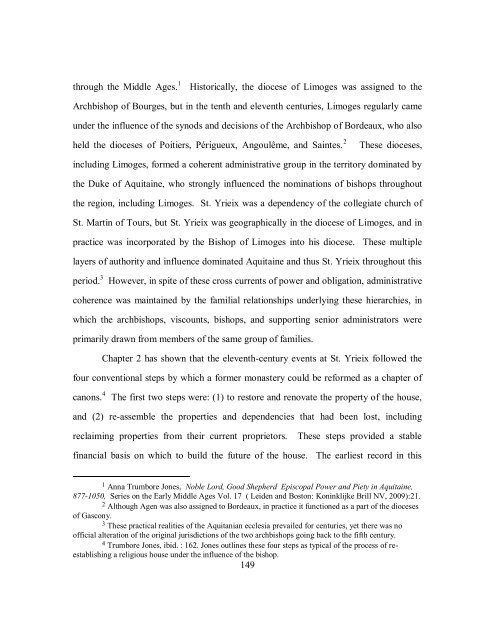Front Matter Template - The University of Texas at Austin
Front Matter Template - The University of Texas at Austin
Front Matter Template - The University of Texas at Austin
You also want an ePaper? Increase the reach of your titles
YUMPU automatically turns print PDFs into web optimized ePapers that Google loves.
through the Middle Ages. 1 Historically, the diocese <strong>of</strong> Limoges was assigned to the<br />
Archbishop <strong>of</strong> Bourges, but in the tenth and eleventh centuries, Limoges regularly came<br />
under the influence <strong>of</strong> the synods and decisions <strong>of</strong> the Archbishop <strong>of</strong> Bordeaux, who also<br />
held the dioceses <strong>of</strong> Poitiers, Périgueux, Angoulême, and Saintes. 2 <strong>The</strong>se dioceses,<br />
including Limoges, formed a coherent administr<strong>at</strong>ive group in the territory domin<strong>at</strong>ed by<br />
the Duke <strong>of</strong> Aquitaine, who strongly influenced the nomin<strong>at</strong>ions <strong>of</strong> bishops throughout<br />
the region, including Limoges. St. Yrieix was a dependency <strong>of</strong> the collegi<strong>at</strong>e church <strong>of</strong><br />
St. Martin <strong>of</strong> Tours, but St. Yrieix was geographically in the diocese <strong>of</strong> Limoges, and in<br />
practice was incorpor<strong>at</strong>ed by the Bishop <strong>of</strong> Limoges into his diocese. <strong>The</strong>se multiple<br />
layers <strong>of</strong> authority and influence domin<strong>at</strong>ed Aquitaine and thus St. Yrieix throughout this<br />
period. 3 However, in spite <strong>of</strong> these cross currents <strong>of</strong> power and oblig<strong>at</strong>ion, administr<strong>at</strong>ive<br />
coherence was maintained by the familial rel<strong>at</strong>ionships underlying these hierarchies, in<br />
which the archbishops, viscounts, bishops, and supporting senior administr<strong>at</strong>ors were<br />
primarily drawn from members <strong>of</strong> the same group <strong>of</strong> families.<br />
Chapter 2 has shown th<strong>at</strong> the eleventh-century events <strong>at</strong> St. Yrieix followed the<br />
four conventional steps by which a former monastery could be reformed as a chapter <strong>of</strong><br />
canons. 4 <strong>The</strong> first two steps were: (1) to restore and renov<strong>at</strong>e the property <strong>of</strong> the house,<br />
and (2) re-assemble the properties and dependencies th<strong>at</strong> had been lost, including<br />
reclaiming properties from their current proprietors. <strong>The</strong>se steps provided a stable<br />
financial basis on which to build the future <strong>of</strong> the house. <strong>The</strong> earliest record in this<br />
1 Anna Trumbore Jones, Noble Lord, Good Shepherd Episcopal Power and Piety in Aquitaine,<br />
877-1050, Series on the Early Middle Ages Vol. 17 ( Leiden and Boston: Koninklijke Brill NV, 2009):21.<br />
2 Although Agen was also assigned to Bordeaux, in practice it functioned as a part <strong>of</strong> the dioceses<br />
<strong>of</strong> Gascony.<br />
3 <strong>The</strong>se practical realities <strong>of</strong> the Aquitanian ecclesia prevailed for centuries, yet there was no<br />
<strong>of</strong>ficial alter<strong>at</strong>ion <strong>of</strong> the original jurisdictions <strong>of</strong> the two archbishops going back to the fifth century.<br />
4 Trumbore Jones, ibid. : 162. Jones outlines these four steps as typical <strong>of</strong> the process <strong>of</strong> reestablishing<br />
a religious house under the influence <strong>of</strong> the bishop.<br />
149

















